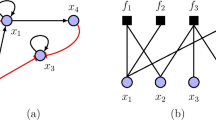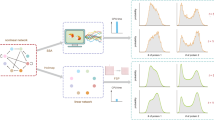Abstract
In the field of theoretical biology the study of the dynamics of the so-called gene regulatory networks is useful to follow the relationship between the expression of a gene and its dynamic regulatory effect on the cell fate. To date, most of the models developed for this purpose, applies the synchronous update schedule while reality is far from being so. On the other hand, the more realistic asynchronous update requires to compute all possible updates at each single instant, thus bearing a much greater computational load.
In the present work, we describe a novel method that addresses the problem of efficiently exploring the dynamics of a gene regulatory network with the asynchronous update.
Access this chapter
Tax calculation will be finalised at checkout
Purchases are for personal use only
Similar content being viewed by others
References
Bérenguier, D., Chaouiya, C., Monteiro, P.T., Naldi, A., Remy, E., Thieffry, D., Tichit, L.: Dynamical modeling and analysis of large cellular regulatory networks. Chaos: Interdisc. J. Nonlinear Sci. 23(2), 025114 (2013)
Bahar, R.I., Frohm, E.A., Gaona, C.M., Hachtel, G.D., Macii, E., Pardo, A., Somenzi, F.: Algebraic decision diagrams and their applications. In: 1993 IEEE/ACM International Conference on Computer-Aided Design, ICCAD 1993, Digest of Technical Papers, pp. 188–191. IEEE (1993)
Bloem, R., Gabow, H.N., Somenzi, F.: An algorithm for strongly connected component analysis in \(n\) log \(n\) symbolic steps. Formal Methods Syst. Des. 28(1), 37–56 (2006)
De Jong, H.: Modeling and simulation of genetic regulatory systems: a literature review. J. Comput. Biol. 9(1), 67–103 (2002)
Dubrova, E., Teslenko, M.: A SAT-based algorithm for finding attractors in synchronous Boolean networks. IEEE/ACM Trans. Comput. Biol. Bioinform. 8(5), 1393–1399 (2011)
Gabow, H.N.: Path-based depth-first search for strong and biconnected components. Inf. Process. Lett. 74(3–4), 107–114 (2000)
Grieco, L., Calzone, L., Bernard-Pierrot, I., Radvanyi, F., Kahn-Perlès, B., Thieffry, D.: Integrative modelling of the influence of mapk network on cancer cell fate decision. PLoS Comput. Biol. 9(10), e1003286 (2013)
Garg, A., Mohanram, K., Di Cara, A., De Micheli, G., Xenarios, I.: Modeling stochasticity and robustness in gene regulatory networks. Bioinformatics 25(12), i101–i109 (2009)
Harvey, I., Bossomaier, T.: Time out of joint: attractors in asynchronous random Boolean networks. In: Proceedings of the Fourth European Conference on Artificial Life, pp. 67–75. MIT Press, Cambridge (1997)
Hopfensitz, M., Müssel, C., Maucher, M.: HA Kestler: attractors in Boolean networks: a tutorial. Comput. Stat. 28(1), 19–36 (2013)
Kauffman, S.A.: The Origins of Order: Self-organization and Selection in Evolution. Oxford University Press, Oxford (1993)
Munro, I.: Efficient determination of the transitive closure of a directed graph. Inf. Process. Lett. 1(2), 56–58 (1971)
Pedicini, M., Barrenäs, F., Clancy, T., Castiglione, F., Hovig, E., Kanduri, K., Santoni, D., Benson, M.: Combining network modeling and gene expression microarray analysis to explore the dynamics of Th1 and Th2 cell regulation. PLoS Comput. Biol. 6(12), e1001032 (2010)
Purdom, P.: A transitive closure algorithm. BIT Numer. Math. 10(1), 76–94 (1970)
Tarjan, R.: Depth-first search and linear graph algorithms. SIAM J. Comput. 1(2), 146–160 (1972)
Veliz-Cuba, A., Laubenbacher, R.: On the computation of fixed points in Boolean networks. J. Appl. Math. Comput. 39(1–2), 145–153 (2012)
Zheng, D., Yang, G., Li, X., Wang, Z., Liu, F., He, L.: An efficient algorithm for computing attractors of synchronous and asynchronous Boolean networks. PLoS ONE 8(4), e60593 (2013)
Author information
Authors and Affiliations
Corresponding author
Editor information
Editors and Affiliations
Rights and permissions
Copyright information
© 2018 Springer International Publishing AG, part of Springer Nature
About this paper
Cite this paper
Pedicini, M., Palumbo, M.C., Castiglione, F. (2018). Computing Hierarchical Transition Graphs of Asynchronous Genetic Regulatory Networks. In: Pelillo, M., Poli, I., Roli, A., Serra, R., Slanzi, D., Villani, M. (eds) Artificial Life and Evolutionary Computation. WIVACE 2017. Communications in Computer and Information Science, vol 830. Springer, Cham. https://doi.org/10.1007/978-3-319-78658-2_7
Download citation
DOI: https://doi.org/10.1007/978-3-319-78658-2_7
Published:
Publisher Name: Springer, Cham
Print ISBN: 978-3-319-78657-5
Online ISBN: 978-3-319-78658-2
eBook Packages: Computer ScienceComputer Science (R0)




